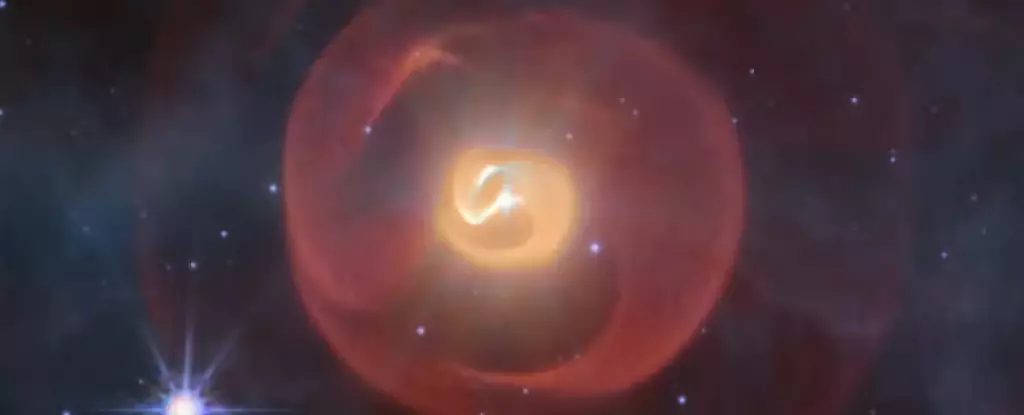For centuries, humanity has gazed at the night sky, captivated by the mysterious dance of stars and the silent stories they whisper. Today, that fascination has evolved into a relentless scientific pursuit to decode the universe’s most violent and beautiful phenomena. The recent triumph utilizing NASA’s James Webb Space Telescope (JWST) marks a pivotal milestone in our cosmic journey. It’s more than just an image—it’s a testament to human ingenuity, curiosity, and our unyielding desire to understand the universe’s most dramatic chapters. This new observation of Apep, a complex binary Wolf-Rayet star system, exemplifies how cutting-edge technology can peel back the layers of cosmic mystery and reveal the intricate ballet of stellar death.
The Revelation of Apep: Beyond Expectations
Initially, the universe appeared to offer a straightforward spectacle—an elegant pinwheel nebula, characteristic of confluences of stellar winds sculpted into spirals through orbital motion. This expectation was rooted in prior knowledge about Wolf-Rayet stars, whose powerful winds often produce such mesmerizing formations. Yet, JWST’s high-resolution infrared imaging challenged these assumptions profoundly. Instead of the anticipated neat spiral, the nebula known as Apep showcased a sprawling, wind-sock shape, indicating an intricate interaction between two nearly equally matched Wolf-Rayet stars. This complexity underscores the universe’s penchant for defying human simplifications and reminds us of the layered richness behind celestial phenomena.
Furthermore, the presence of a third, more distant star complicates the narrative, hinting at an even larger, more dynamically complex system than previously thought. The new data from JWST allowed scientists to analyze how dust streams expand, cool, and form over vast regions, painting a picture of a cosmic environment far more elaborate than an initial glance would suggest. These findings exemplify the importance of technological advancement—what once looked like a simple nebula now reveals itself as a multifaceted stellar nursery and graveyard mixed into a tangled web of gravitational interactions.
The Power of Advanced Imaging in Cosmic Forensics
Infrared imaging capability, akin to thermal cameras in terrestrial applications, has revolutionized our cosmic perspective. By highlighting hot and cold regions within the nebula, JWST provides a detailed thermal map that uncovers the physical processes driving stellar wind interactions. Such detailed mappings allow scientists like Han and White to connect observed dust structures directly to underlying stellar mechanics, transforming celestial observations into a form of cosmic forensics.
What’s truly compelling is the revelation of multiple concentric shells, each representing different epochs of dust ejected by these stars. This layered dust not only chronicles the recent violent deaths of massive stars but also offers insights into their evolutionary histories. The fact that these shells are evenly spaced suggests a regular, perhaps cyclical, pattern of mass-loss activity, which has profound implications for understanding stellar life cycles, especially for the most massive stars that end their lives in catastrophic supernovae.
These insights extend beyond mere curiosity—they challenge existing models of stellar winds and rotation. Initial theories speculated that rapid stellar spins and equatorial winds could produce certain dust features; however, JWST’s detailed data illustrates that the reality is far more nuanced. The cooling patterns and shell formations suggest variations in star brightness, distance, and wind dynamics that keep redefining our understanding of stellar demise.
Reinventing the Narrative of Stellar Endings
One of the most significant scientific gains from JWST’s observations is the recognition of a multi-star system—two Wolf-Rayet stars paired with a third stellar companion—that functions like a celestial family with complex interactions. This discovery challenges the simplistic binary models often assumed in stellar evolution studies. The third star, actively “chewing” into the dust shells, introduces a new element of dynamism, turning our previous binary assumption into a more intricate triple-star dance.
This multi-star dynamic is not a mere detail; it is a window into the violent processes that seed the universe with heavy elements and carbon dust—the fundamental building blocks of planets, life, and even ourselves. The violent convulsions, winds, and eventual explosions shape the cosmic medium, influencing galaxy evolution and the cycle of matter recycling throughout the universe.
Moreover, these geometrical and physical irregularities serve as a reminder that the universe operates on principles that are often chaotic yet interconnected. The “bites” taken out of dust shells portray a universe that is both destructive and creative—an ongoing cycle of death and rebirth that defines our cosmic understanding. The beauty of these structures lies in their apparent simplicity, but beneath that veneer is a story of turbulent forces, gravitational intricacies, and cosmic timing, all captured vividly by the JWST.
Embracing the Uncertainty and the Infinite Beauty of the Cosmos
The process of unlocking these stellar secrets is ongoing and fraught with surprises. Each new layer of discovery—whether it’s the formation of multiple dust shells, the influence of a hidden companion star, or the cooling behaviors of dust in space—reminds us of the universe’s vast complexity. It is a testament to our collective scientific spirit that we can interpret these cosmic cues to reconstruct the puzzle of stellar death, from violent explosions to delicate dust formation.
Yet, perhaps the most profound takeaway is the humility these discoveries inspire. Humanity’s quest to understand the cosmos remains a humbling journey; our models are continuously refined, and our understanding deepened with each new observation. As JWST continues to probe the universe with unprecedented clarity, one thing is clear: our universe is a constantly unfolding story of chaos and order, destruction and creation—a narrative that we are privileged to decipher, one photon at a time.

